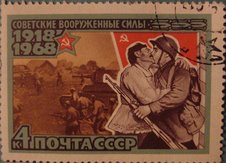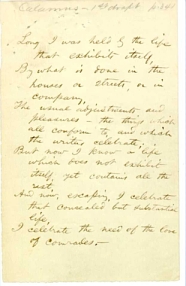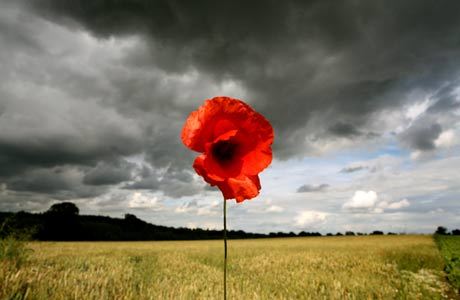”Whitman Making Books, Books Making Whitman” by Ed Folsom
URL: http://www.whitmanarchive.org/criticism/current/anc.00150.html
All Times&Moods of the Good Gray Poet
An outline of Whitman’s work which opens a new perspective to his work, drawing our attention to the whole range of Whitman’s bookmaking activities and revealing how those skills influenced his work, but also how those mere physical objects may tell us something about his work, life and his times. He put a tremendous effort in making his book because he believed that the book had a power to speak to its readers in different ways. The physicality of his book was as much important as the human body was to him. He wanted us, while holding his book, to feel it, smell it, and touch it with our naked hands in the same way we would feel, smell and touch a body. Well aware that either the content or the physicality of his book might not speak to its readers immediately, he said he would be waiting for us in his books and “on” his books.
The book covers all the major points in each of editions of Leaves of Grass. So, we are presented with the first edition of Leaves of Grass (1855), for which he designed the cover, chose the binding and set some of the type himself. With such an innovative and unusual design, Whitman tried to send a message that “the American poetry would have to be essentially different from any poetry written previously—it would have to look different, sound different, and deal with different subject matter if it was to guide the development of a radical new American democracy.” Not only the content of the book, but also the book as a physical object was perceived as “unusual in size, ornamentation, and design”. “The book itself is a hundred times more curious. It is like no other book that ever was written.” “Everything about the external arrangement of this book is odd and out of the way.” Almost all the reviewers commented on the absence of the author’s name and the odd frontispiece engraving. “The man is the true impersonation of his book—rough, uncouth, vulgar.” Charles Eliot Norton, in his Putnam’s Monthly review, summed up the feeling of many when he described it as “this gross yet elevated, this superficial yet profound, this preposterous yet somehow fascinating book.”
It was followed by the second edition of Leaves of Grass (1856) which “demonstrates Whitman’s changing attitudes toward his book and toward the goals he had for his work.” He wanted working people carry his “pocket-size” edition poetry and read it during breaks.
The third edition of Leaves of Grass (1860) came with 146 new poems, the first edition of Leaves published by a true publisher, Thayer and Eldridge. Many of the previous poems had undergone extensive revision. This is the first time “Calamus” poems appear, a cluster devoted to male-male affection, along with “Enfans d’Adam,” later renamed “Children of Adam,” a group of poems dealing with male-female attraction. Once again we witness an interaction between the physicality of the book (Whitman redesigned his title page to turn the very letters of “Leaves of Grass” into sperm, adding the distinctive tails that had become familiar in medical textbooks of the time) and its content (a lot of controversial sexual spermatic images, representing Whitman’s words “as the seeds for new ideas, a new nation, a new conception of democracy, but his words would need to penetrate readers and fertilize their imaginations”).
The same intention is preserved with Drum-Taps (1865) and Sequel to Drum-Taps (1865–66), a collection of war poems, where the title’s letters, formed out of broken limbs and branches, are visually alluding to the reconstruction the nation would be going through as it tried to form a union again out of the shattered fragments of the war. As if the title page indicates he is making his poetry out of “the debris and debris of all dead soldiers” and “the staffs all splinter’d and broken.”
Furthermore, we are given all the crucial facts regarding the fourth edition of Leaves of Grass (1867), the least studied and impressive one and the most difficult to find, the first British edition of Poems by Walt Whitman (1868), published by John Camden Hotten and edited by the British critic William Michael Rossetti, the fifth edition of Leaves (1871) what he called “my new & improved edition,” and his Passage to India (1871), the “Supplementary Volume” to be dedicated to giving voice to “Democratic Nationality” and the sixth edition of Leaves of Grass (1881), where Whitman totally rearranged his poems and clustered them in new arrangements.
There are also presentations of his other works like Democratic Vistas, Two Rivulets and Specimen Days & Collect, Memoranda During the War, November Boughs, Complete Poems & Prose.
Whitman’s own bookmaking ceased with the final edition, known as the “Deathbed Edition” (1891-92), created just before Whitman died, and considered to be the authoritative edition of Leaves of Grass. He wrote “L. of G. at last complete—after 33 y’rs of hackling at it, all times & moods of my life, fair weather & foul, all parts of the land, and peace & war, young & old”.
We are given a handful of beautiful and useful images showing Whitman progress and develop not only as a bookmaker but also as a poet and as a man. We have come to realise all the greatness of his legacy, his books speaking for years and years after his death, executing that very mission he had in mind when writing his poetry and making his books of an ongoing process of realisation and self-realisation. As Ed Folsom brilliantly describes:
“Bookmakers, like all readers of Whitman, have continued to make Whitman over in various guises, to create new Walt Whitmans—a Whitman who speaks particularly to the gay community, an ecological Whitman whose work resonates with the green movement, a socialist Whitman dedicated to a poetry of the working-class, a patriotic Whitman who celebrates America, a Whitman who speaks in an open and unaffected way to children, a Whitman who speaks across language and culture to Spanish and German and Arabic and Chinese readers. There are as many Whitmans as there are readers, and the nature of his project was to leave it to us to define him, to do the work that would make his poetry come alive for us, speak to us not just from his past but from our present. “

 After having discussed the phrenological term “adhesiveness” this Saturday during our class, used to refer to the attachment between men, the word “comrade” caught my attention while I was reading “In Paths Untrodden” from the “Calamus” cluster. “Adhesiveness” and “comrade” evoke at first “sticky or gluey” and “a companion or a member of the Communist Party”, respectively, however both bearing a hidden connotation. Notably, taking into consideration that “Calamus” takes its name from an herb with pointy, narrow leaves which shape is suggestive of an erect phallus, that the poems in the “Calamus” cluster are held together by the sentiment of “male bonding” or “manly attachment”, that the title of this poem is very suggestive (“paths untrodden”), we start seeing the word “comrade” in a different light. Isn’t it beautiful to reveal layer by layer all what words comprise? I looked up the word “comrade” and this is what I found:
After having discussed the phrenological term “adhesiveness” this Saturday during our class, used to refer to the attachment between men, the word “comrade” caught my attention while I was reading “In Paths Untrodden” from the “Calamus” cluster. “Adhesiveness” and “comrade” evoke at first “sticky or gluey” and “a companion or a member of the Communist Party”, respectively, however both bearing a hidden connotation. Notably, taking into consideration that “Calamus” takes its name from an herb with pointy, narrow leaves which shape is suggestive of an erect phallus, that the poems in the “Calamus” cluster are held together by the sentiment of “male bonding” or “manly attachment”, that the title of this poem is very suggestive (“paths untrodden”), we start seeing the word “comrade” in a different light. Isn’t it beautiful to reveal layer by layer all what words comprise? I looked up the word “comrade” and this is what I found:



